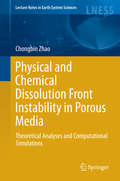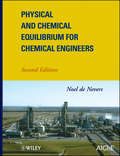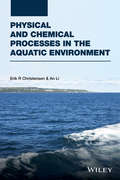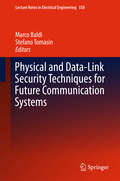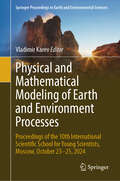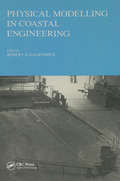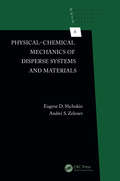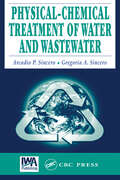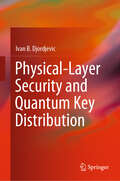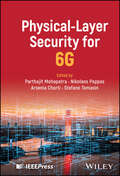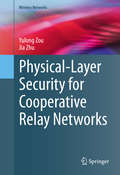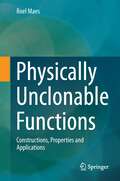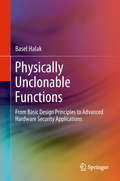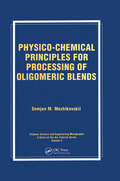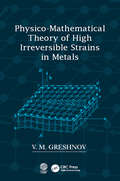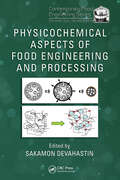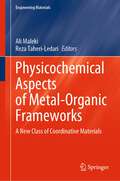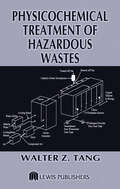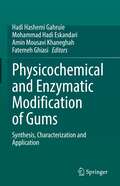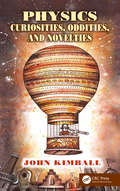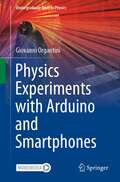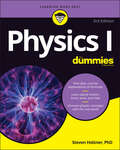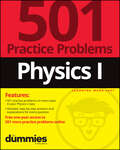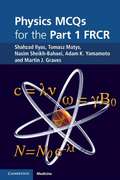- Table View
- List View
Physical and Chemical Dissolution Front Instability in Porous Media
by Chongbin ZhaoThis monograph provides state-of-the-art theoretical and computational findings from investigations on physical and chemical dissolution front instability problems in porous media, based on the author's own work. Although numerical results are provided to complement theoretical ones, the focus of this monograph is on the theoretical aspects of the topic and those presented in this book are applicable to a wide range of scientific and engineering problems involving the instability of nonlinear dynamic systems. To appeal to a wider readership, common mathematical notations are used to derive the theoretical solutions. The book can be used either as a useful textbook for postgraduate students or as a valuable reference book for computational scientists, mathematicians, engineers and geoscientists.
Physical and Chemical Equilibrium for Chemical Engineers
by Noel De NeversThis book concentrates on the topic of physical and chemical equilibrium. Using the simplest mathematics along with numerous numerical examples it accurately and rigorously covers physical and chemical equilibrium in depth and detail. It continues to cover the topics found in the first edition however numerous updates have been made including: Changes in naming and notation (the first edition used the traditional names for the Gibbs Free Energy and for Partial Molal Properties, this edition uses the more popular Gibbs Energy and Partial Molar Properties,) changes in symbols (the first edition used the Lewis-Randal fugacity rule and the popular symbol for the same quantity, this edition only uses the popular notation,) and new problems have been added to the text. Finally the second edition includes an appendix about the Bridgman table and its use.
Physical and Chemical Processes in the Aquatic Environment
by An Li Erik R. Christensend transformation. The book also includes the most up to date information including a discussion on emerging pollutants such as brominated and phosphate flame retardants, perflurochemicals, and pharmaceutical and personal care products. Due to its importance an ecotoxicology chapter has been included featuring molecular biological methods, nanoparticles, and comparison of the basis of biotic ligand model with the Weibull dose-response model. Finally, the last chapter briefly summarizes the regulations on ambient water quality.
Physical and Data-Link Security Techniques for Future Communication Systems
by Marco Baldi Stefano TomasinThis book focuses on techniques that can be applied at the physical and data-link layers of communication systems in order to secure transmissions against eavesdroppers. Topics ranging from information theory-based security to coding for security and cryptography are discussed, with presentation of cutting-edge research and innovative results from leading researchers. The characteristic feature of all the contributions is their relevance for practical embodiments: detailed consideration is given to applications of security principles to a variety of widely used communication techniques such as multiantenna systems, ultra-wide band communication systems, power line communications, and quantum key distribution techniques. A further distinctive aspect is the attention paid to both unconditional and computational security techniques, providing a bridge between two usually distinct worlds. The book comprises extended versions of contributions delivered at the Workshop on Communication Security, held in Ancona, Italy, in September 2014 within the framework of the research project "Enhancing Communication Security by Cross-layer Physical and Data-link Techniques", funded by the Italian Ministry of Education, Universities, and Research.
Physical and Mathematical Modeling of Earth and Environment Processes: Proceedings of the 10th International Scientific School for Young Scientists, Moscow, October 18–20, 2024 (Springer Proceedings in Earth and Environmental Sciences)
by Vladimir KarevThe book presents short papers of participants of the 10th International Scientific Conference and School for Young Scientists «Physical and Mathematical Modeling of Earth and Environment Processes. The book includes theoretical and experimental studies of processes in the atmosphere, oceans, the lithosphere and their interaction; environmental issues; problems of human impact on the environment; methods of geophysical research. Research of the dynamic of natural systems - geosphere, hydrosphere, atmosphere and their interactions, the human contribution to naturally occurring processes are among the most urgent and practically important scientific problems. Intensive development of research in these areas is due to several factors. The widespread introduction of computer technology has allowed beginning calculation of complex phenomena, previously unavailable for analysis. Creation and improvement of a new generation of geophysical instruments, remote observing systems based on the ship, aircraft, and satellite allowed us to obtain a large amount of data to objectively reflect the picture of the processes. The articles included in these book reflect also an important role of the laboratory modeling in searching of processes in geo-environments and testing of new developed physical and mathematical models. Development of measurement, optic information and other techniques provide new opportunities to perform controllable and reproducible laboratory data for generations of new ideas and concepts. Systematic stream of high resolution laboratory data stimulates development of analytical and numerical models of the dynamical processes in three nature environments. A special focus is given to the extraction of hydrocarbon resources, including from unconventional sources. An alternative to the use of hydrocarbons as a main source of energy on the Planet in the coming decades is unlikely to be found. At the same time, the resource base of hydrocarbons is quickly depleted, in particularly, large and accessible oil and gas fields. The shale oil and gas, Arctic hydrocarbon stocks, gas hydrates, coal bed methane, oil and gas from deep horizons can become new sources.
Physical and Statistical Models for Steam Generator Clogging Diagnosis
by Sylvain GirardClogging of steam generators in nuclear power plants is a highly sensitive issue in terms of performance and safety and this book proposes a completely novel methodology for diagnosing this phenomenon. It demonstrates real-life industrial applications of this approach to French steam generators and applies the approach to operational data gathered from French nuclear power plants. The book presents a detailed review of in situ diagnosis techniques and assesses existing methodologies for clogging diagnosis, whilst examining their limitations. It also addresses numerical modelling of the dynamic behaviour of steam generators and provides a thorough analysis of statistical methods for sensitivity analysis and dimension reduction. Steam generators are heat exchangers found in nuclear power plants and over time they become increasingly clogged by iron oxides. This clogging then hampers the flow inside steam generators and compromises their mechanical integrity, which hinders performance and safety. This book is intended for nuclear safety specialists, nuclear performance engineers and researchers and postgraduate students working on heat exchanger modeling and computational engineering.
Physical modelling in coastal engineering: Proceedings of an international conference, Newark, Delaware, August 1981
by Robert A. DalrympleCoastal engineering is a field which has grown in importance over the last forty years as mankind has utilised and become dependent on the coastlines of the world to a greater extent. The activities in the field include the study of wave dynamics, shoreline erosion and protection, harbor and breakwater design, dredging technology, estuary mechanics and storm surge calculations, as well as offshore structural design. In all of these areas the level of actvity is high and the state of art has imporved dramatically since the 1940's. An important aspect of all these areas of research is the use of model studies. This volume consists of a number of papers which cover various aspects of physical modelling in coastal engineering, including the generation of waves in the laboratory, the modelling of sediment transport and the application to various engineering problems. The intent is to provide the reader with an overview of the research actvities of indviduals who represent major laboratories in their countries: to include Denmark, Scotland, Canada, the People's Republic of China, England, the Netherlands and the U.S.
Physical-Chemical Mechanics of Disperse Systems and Materials (Progress in Colloid and Interface Science)
by Eugene D. Shchukin Andrei S. ZelenevPhysical-Chemical Mechanics of Disperse Systems and Materials is a novel interdisciplinary area in the science of the disperse state of matter. It covers the broad spectrum of objects and systems with dimensions ranging from nanometers to millimeters and establishes a fundamental basis for controlling and tuning the properties of these systems as w
Physical-Chemical Treatment of Water and Wastewater
by Arcadio P. Sincero Gregoria A. SinceroThe books currently available on this subject contain some elements of physical-chemical treatment of water and wastewater but fall short of giving comprehensive and authoritative coverage. They contain some equations that are not substantiated, offering empirical data based on assumptions that are therefore difficult to comprehend. This text bring
Physical-Layer Security and Quantum Key Distribution
by Ivan B. DjordjevicThis textbook integrates the most advanced topics of physical-layer security, cryptography, covert/stealth communications, quantum key distribution (QKD), and cyber security to tackle complex security issues. After introducing the reader to various concepts and practices, the author addresses how these can work together to target problems, rather than treating them as separate disciplines. This book offers students an in-depth exposition on: cryptography, information-theoretic approach to cryptography, physical-layer security, covert/stealth/low-probability of detection communications, quantum information theory, QKD, and cyber security; to mention few. The goal is to provide a unified description of the most advanced topics related to: (i) modern cryptography, (ii) physical-layer security, (iii) QKD, (iv) covert communications, and (v) cyber security. Each chapter is followed by a set of problems. Also, for readers to better understand the book, an appendix covers all needed background. Homework problems and lecture notes are available online. The book does not require any prior knowledge or prerequisite material.
Physical-Layer Security for 6G
by Stefano Tomasin Nikolaos Pappas Parthajit Mohapatra Arsenia ChortiMeet the wireless security challenges of the future with this key volume The 6th generation of wireless communication technology—known as 6G—promises to bring both revolutionary advances and unique challenges. Secure communications will be harder than ever to achieve under the new integrated ground, air, and space networking paradigm, with increased connectivity creating the potential for increased vulnerability. Physical-layer security, which draws upon the physical properties of the channel or network to secure information, has emerged as a promising solution to these challenges. Physical-Layer Security for 6G provides a working introduction to these technologies and their burgeoning wireless applications. With particular attention to heterogeneous and distributed network scenarios, this book offers both the information-theory fundamentals and the most recent developments in physical-layer security. It constitutes an essential resource for meeting the unique security challenges of 6G. Physical-Layer Security for 6G readers will also find: Analysis of physical-layer security in the quality of security framework (QoSec)Detailed discussion of physical-layer security applications in visible light communication (VLC), intelligence reflecting surface (IRS), and morePractical use cases and demonstrations Physical-Layer Security for 6G is ideal for wireless research engineers as well as advanced graduate students in wireless technology.
Physical-Layer Security for Cooperative Relay Networks
by Yulong Zou Jia ZhuThis book presents physical-layer security as a promising paradigm for achieving the information-theoretic secrecy required for wireless networks. It explains how wireless networks are extremely vulnerable to eavesdropping attacks and discusses a range of security techniques including information-theoretic security, artificial noise aided security, security-oriented beamforming, and diversity assisted security approaches. It also provides an overview of the cooperative relaying methods for wireless networks such as orthogonal relaying, non-orthogonal relaying, and relay selection. Chapters explore the relay-selection designs for improving wireless secrecy against eavesdropping in time-varying fading environments and a joint relay and jammer selection for wireless physical-layer security, where a relay is used to assist the transmission from the source to destination and a friendly jammer is employed to transmit an artificial noise for confusing the eavesdropper. Additionally, the security-reliability tradeoff (SRT) is mathematically characterized for wireless communications and two main relay-selection schemes, the single-relay and multi-relay selection, are devised for the wireless SRT improvement. In the single-relay selection, only the single best relay is chosen for assisting the wireless transmission, while the multi-relay selection invokes multiple relays for simultaneously forwarding the source transmission to the destination. Physical-Layer Security for Cooperative Relay Networks is designed for researchers and professionals working with networking or wireless security. Advanced-level students interested in networks, wireless, or privacy will also find this book a useful resource.
Physically Unclonable Functions
by Roel MaesPhysically unclonable functions (PUFs) are innovative physical security primitives that produce unclonable and inherent instance-specific measurements of physical objects; in many ways they are the inanimate equivalent of biometrics for human beings. Since they are able to securely generate and store secrets, they allow us to bootstrap the physical implementation of an information security system. In this book the author discusses PUFs in all their facets: the multitude of their physical constructions, the algorithmic and physical properties which describe them, and the techniques required to deploy them in security applications. The author first presents an extensive overview and classification of PUF constructions, with a focus on so-called intrinsic PUFs. He identifies subclasses, implementation properties, and design techniques used to amplify submicroscopic physical distinctions into observable digital response vectors. He lists the useful qualities attributed to PUFs and captures them in descriptive definitions, identifying the truly PUF-defining properties in the process, and he also presents the details of a formal framework for deploying PUFs and similar physical primitives in cryptographic reductions. The author then describes a silicon test platform carrying different intrinsic PUF structures which was used to objectively compare their reliability, uniqueness, and unpredictability based on experimental data. In the final chapters, the author explains techniques for PUF-based entity identification, entity authentication, and secure key generation. He proposes practical schemes that implement these techniques, and derives and calculates measures for assessing different PUF constructions in these applications based on the quality of their response statistics. Finally, he presents a fully functional prototype implementation of a PUF-based cryptographic key generator, demonstrating the full benefit of using PUFs and the efficiency of the processing techniques described. This is a suitable introduction and reference for security researchers and engineers, and graduate students in information security and cryptography.
Physically Unclonable Functions: From Basic Design Principles To Advanced Hardware Security Applications
by Basel HalakThis book discusses the design principles of physically unclonable functions (PUFs) and how these can be employed in hardware-based security applications, in particular, the book provides readers with a comprehensive overview of security threats and existing countermeasures.This book has many features that make it a unique source for students, engineers and educators, including more than 80 problems and worked exercises, in addition to, approximately 200 references, which give extensive direction for further reading.
Physico-Chemical Principles for Processing of Oligomeric Blends (Polymer Science and Engineering Monographs)
by Semjon M MezhikouskiCovers the current state of theoretical and experimental studies of oligomeric mixed systems from the physico-chemical standpoint and provides a technologist with the means for the quantitative approach to preparing liquid oligomeric compositions and choosing proper operating conditions for their processing into materials and articles. Recommendations are given on the practical use of found physico-patterns as well as the physico-chemical analysis of the effect of the composition ingredients on the final properties.
Physico-Mathematical Theory of High Irreversible Strains in Metals
by V. M. GreshnovPresents a new physical and mathematical theory of irreversible deformations and ductile fracture of metals that acknowledges the continuous change in the structure of materials during deformation and the accumulation of deformation damage. Plastic deformation, viscous destruction, evolution of structure, creep processes, and long-term strength of metals and stress relaxation are described in the framework of a unified approach and model. The author then expands this into a mathematical model for determining the mechanical characteristics of quasi-samples of standard mechanical properties in deformed semi-finished products.
Physicochemical Aspects of Food Engineering and Processing (Contemporary Food Engineering Ser.)
by Sakamon DevahastinPhysical and chemical interactions between various constituents of foods resulting from processing operations often lead to physical, sensory, and nutritional changes in the properties of foods. Answering the need for a resource in this area, this volume describes the effects of various processing technologies in different food processing situations. A first part looks at the physicochemical property changes of different foods undergoing selected processes, such as drying, extrusion, microencapsulation, and microwave assisted thermal processing. The second part focuses on the changes of physicochemical properties of different products, such as seafood, meat, and confectionary products.
Physicochemical Aspects of Metal-Organic Frameworks: A New Class of Coordinative Materials (Engineering Materials)
by Ali Maleki Reza Taheri-LedariThis book presents a both detailed and comprehensive look at metal–organic frameworks (MOFs), a relatively new class of materials with a broad application potential. The beginning chapters focus on introducing the requisite fundamental knowledge of MOFs with respect to their classification, synthesis, functionalization approaches, and various other physiochemical facets such as structural morphology and coordination chemistry. The remaining chapters cover an array of diverse applications, from areas such as energy storage and environmental remediation, to drug delivery, biosensing, and tissue engineering.Featuring chapters dedicated to the design of novel MOF structures, as well as theoretical calculations via density functional theory and machine learning techniques, this book targets a wide readership of both academic and industrial researchers interested in an in-depth understanding of the latest MOF structure–function relationships, as well as their deployment in a wide variety of coordinated engineering applications.
Physicochemical Treatment of Hazardous Wastes
by Walter Z. TangThis book examines the treatability of hazardous wastes by different physicochemical treatment processes according to the Quantitative Structure and Activity Relationship (QSAR) between kinetic rate constants and molecular descriptors. The author explores how to use these models to select treatment processes according to the molecular structure of
Physicochemical and Enzymatic Modification of Gums: Synthesis, Characterization and Application
by Amin Mousavi Khaneghah Hadi Hashemi Gahruie Mohammad Hadi Eskandari Fatemeh GhiasiNatural gums are polysaccharides consisting of multiple sugar units linked together via glycosidic linkages. Most natural gums reveal appropriate safety for oral consumption in the form of food additives or drug carriers. Challenges related to the utilization of natural polysaccharides, however, include uncontrolled rates of hydration, pH dependent solubility, viscosity reduction during storage, and weak interfacial properties. Modification provides an efficient route for not only removing such drawbacks but also improving physicochemical properties, such as solubility, viscosity and swelling index, and introducing new properties for varied applications.This book provides a comprehensive review of the various modifications on gums to make them suitable for food, cosmetic and pharmaceutical industries. The book is divided in four parts: an introduction to natural gums followed by in-depth coverage of chemical modification, physical modification, and enzymatic modification of gums. Each chapter includes reaction mechanisms, physicochemical properties, rheological properties, interfacial properties, applications and future perspectives. Presenting a succinct account on gum modification from a practical point of view, this book is a helpful reference for academic and industrial scientists and engineers in food technology, materials chemistry, pharmaceuticals, chemical, industrial, and applied engineering, biochemistry, and biopolymers.
Physics Curiosities, Oddities, and Novelties
by John KimballAn Enlightening Way to Navigate through Mind-Boggling Physics ConceptsPhysics Curiosities, Oddities, and Novelties highlights unusual aspects of physics and gives a new twist to some fundamental concepts. The book covers both classical and modern physics in an engaging, straightforward style.The author presents perplexing questions that often lack
Physics Experiments with Arduino and Smartphones (Undergraduate Texts in Physics)
by Giovanni OrgantiniThis book on the use of Arduino and Smartphones in physics experiments, with a focus on mechanics, introduces various techniques by way of examples. The main aim is to teach students how to take meaningful measurements and how to interpret them. Each topic is introduced by an experiment. Those at the beginning of the book are rather simple to build and analyze. As the lessons proceed, the experiments become more refined and new techniques are introduced. Rather than providing recipes to be adopted while taking measurements, the need for new concepts is raised by observing the results of an experiment. A formal justification is given only after a concept has been introduced experimentally. The discussion extends beyond the taking of measurements to their meaning in terms of physics, the importance of what is learned from the laws that are derived, and their limits. Stress is placed on the importance of careful design of experiments as to reduce systematic errors and on good practices to avoid common mistakes. Data are always analyzed using computer software. C-like structures are introduced in teaching how to program Arduino, while data collection and analysis is done using Python. Several methods of graphical representation of data are used.
Physics I For Dummies
by Steven HolznerAn easy-to-follow guide to introductory physics, from the Big Bang to relativity All science, technology, engineering, and math majors in college and university require some familiarity with physics. Other career paths, like medicine, are also only open to students who understand this fundamental science. But don’t worry if you find physics to be intimidating or confusing. You just need the right guide! In Physics I For Dummies, you’ll find a roadmap to physics success that walks you through every major topic in introductory physics, including motion, energy, waves, thermodynamics, electromagnetism, relativity, and more. You’ll learn the basic principles and math formulas of physics through clear and straightforward examples and instruction, and without unnecessary jargon or complicated theory. In this book, you’ll also find: Up-to-date examples and explanations appearing alongside the latest discoveries and research in physics, discussed at a level appropriate for beginning students All the info found in an intro physics course, arranged in an intuitive sequence that will give first-year students a head start in their high school or college physics class The latest teaching techniques to ensure that you remember and retain what you read and practice in the bookPhysics I For Dummies is proof that physics can fun, accessible, challenging, and rewarding, all at the same time! Whether you’re a high school or undergraduate student looking for a leg-up on basic physics concepts or you’re just interested in how our universe works, this book will help you understand the thermodynamic, electromagnetic, relativistic, and everything in between.
Physics I: 501 Practice Problems For Dummies (+ Free Online Practice)
by The Experts at DummiesOvercome your study inertia and polish your knowledge of physics Physics I: 501 Practice Problems For Dummies gives you 501 opportunities to practice solving problems from all the major topics covered you Physics I class—in the book and online! Get extra help with tricky subjects, solidify what you’ve already learned, and get in-depth walk-throughs for every problem with this useful book. These practice problems and detailed answer explanations will help you succeed in this tough-but-required class, no matter what your skill level. Thanks to Dummies, you have a resource to help you put key concepts into practice. Work through practice problems on all Physics I topics covered in school classes Step through detailed solutions to build your understanding Access practice questions online to study anywhere, any time Improve your grade and up your study game with practice, practice, practiceThe material presented in Physics I: 501 Practice Problems For Dummies is an excellent resource for students, as well as parents and tutors looking to help supplement Physics I instruction. Physics I: 501 Practice Problems For Dummies (9781119883715) was previously published as Physics I Practice Problems For Dummies (9781118853153). While this version features a new Dummies cover and design, the content is the same as the prior release and should not be considered a new or updated product.
Physics MCQs for the Part 1 FRCR
by Tomasz Matys Nasim Sheikh-Bahaei Adam K. Yamamoto Shahzad Ilyas Martin John GravesPhysics MCQs for the Part 1 FRCR is a comprehensive and practical revision tool for the new format Part 1 FRCR examination, covering the complete physics curriculum. Key features: * Contains 300 questions that reflect the style and difficulty of the real exam * Covers basic physics, radiation legislation and all the imaging modalities included in the Royal College of Radiologists training curriculum and new FRCR examination * Includes new exam topics such as MRI and ultrasound imaging * Answers are accompanied by clear, detailed explanations giving candidates in-depth understanding of the topic * Much of the question material is based on the Radiology-Integrated Training Initiative (RITI), as recommended by the Royal College of Radiologists A must-have revision resource for all Part 1 FRCR candidates, Physics MCQs for the Part 1 FRCR is written by a team of specialist registrars who have recently successfully passed the Part 1 FRCR exam and a renowned medical physicist.
